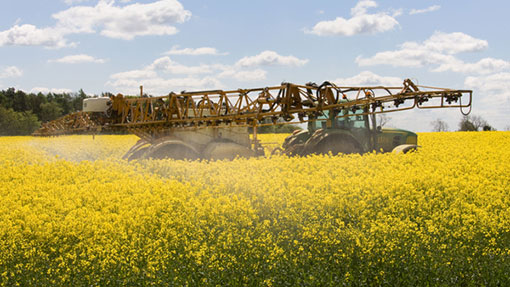Light leaf spot warning for OSR growers

The risk of a light leaf spot epidemic in oilseed rape crops is high and growers are being warned that additional fungicide sprays might be needed to keep the disease at bay.
The latest Rothamsted Research light leaf spot risk forecast , which takes account of winter rainfall from December 2013 to February 2014, shows the high risk applies to all regions.
FERA’s Crop Monitor survey data has also highlighted the problem, with 88% of crops infected and within those crops, 44% of plants carried the disease – the highest levels seen since 1989.
The disease is typically more prevalent in northern rape crops; however, the high winter rainfall in southern areas of Great Britain has seen the risk of infection increase nationwide.
See also: Boost profits by growing healthy oilseed
Light leaf spot is usually suppressed by an autumn fungicide programme that also targets phoma, but ADAS plant pathologist Faye Ritchie says these fungicides run out of steam, which allows the disease back into the crop in January.
“It’s been spread by rain splash and it’s important that growers get out and check crops now, even if they have already applied a fungicide this spring.
“They might have to treat again at early- to mid-flowering to supress the disease and keep it off the yield forming branches and pods,” says Dr Ritchie.
Jon West of Rothamsted Research adds that his team was surprised when assessing their experimental field plots this past week, with some varieties having very little infection, but others suffering severe infection that could have a considerable impact on final yield.
“Overall the level of disease seems moderately high this season, but there’s definitely a large varietal effect,” says Dr West.
In Yorkshire, AICC independent agronomist Patrick Stephenson has seen high levels of light leaf spot, but notes that it is not endemic in all oilseed rape crops.
Many of his clients will have already treated their rape crops with a growth regulatory fungicide such as tebuconazole that will have given some activity on the disease and around three to four weeks protection.
“That protection wearing off will coincide with the mid-flowering sclerotinia spray and if the predictions of high risk are correct and conditions favour the disease, activity will be needed in those treatments,” says Mr Stephenson.
He says a prothioconazole-based product will be the treatment of choice to give strong activity on both diseases at this timing.
In the South, Agrovista agronomist Tim Bullock is seeing less light leaf spot incidence out in his fields across Wiltshire and Gloucestershire, but acknowledges the risk is there, so growers should be vigilant and treat if symptoms occur.
“In trials that haven’t received a fungicide so far the disease is there and if there is an outbreak early on it can be very damaging,” says Mr Bullock.
Consider canopy
If a further light leaf spot treatment is required, those growers that have already applied a fungicide with growth regulatory activity this spring will need to pay careful attention to product choice.
Mr Stephenson says where further shortening is required on top of light leaf spot control; adding tebuconazole into a mix with boscalid is one option, but favours using a specific growth regulator such as Caryx (mepiquat + metconazole) if necessary.
“It might mean an extra pass through the crop, which is not ideal, but will give a better result,” he adds.

